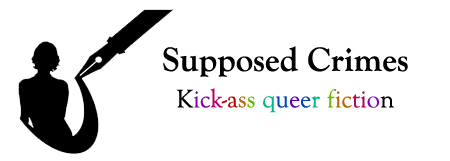
A colleague shared the other day about people within the LGBTQIA+ community monitoring and judging how others express their gender and sexuality. It led me to thinking about how in writing, we often expect characters to “perform” their sexuality in a way that still allows readers to mentally catalogue them. This is of specific interest to me as a nonbinary bisexual person.
I’ve found that often, people whose gender and sexuality are binary don’t quite capture certain nuances. (The same can actually be said in reverse, to be honest, but I can’t speak authoritatively on that.) We are subject to a particular kind of misunderstanding and antagonism unique to who we are.
There are obviously many ways in which nonbinary and multisexual (bi, pan, etc.) people are subjected to this. I ran across two of them recently, so those are the ones I’m talking about today.
First, the endless Bi vs. Pan debates. And I do mean endless. It comes up constantly because people are forever trying to pit us against each other as if there’s not room for people to decide for themselves what word to use. Nine times out of ten, we get defined in opposition to each other, despite there being plenty of overlap. It also often boils down to either “pansexual people will date more than just men and women” or “pansexual people will date trans people.” Sometimes it’s framed as “hearts not parts,” as if bisexual people are only attracted to genitals or as if pansexual people are not allowed to have any preference at all for gender when dating.
It’s ridiculous. If you were to ask 100 people why they chose which word to use, you’d likely get 100 different answers. Leave people alone, and if you’re not bi or pan or any other non-monosexual identity, stop trying to define our words for us according to what you think they mean.
Second, I read a truly awful op-ed (not linking so as not to give TERFs more clicks). This time, it became Women vs. Female-Assigned Non-Binary People. The author of the piece claimed that AFAB nonbinary folks are somehow invalidating both cisgender and transgender women by way of “not wanting to be women.” Well, the whole point is that we aren’t women, so no, we aren’t somehow invalidating actual women (and specifically lesbians) by our existence, nor by highlighting that we have a unique place in the world.
What this writer did was subject us to something called misplaced misogyny. It’s the assumption that a person is “really” a woman exclusively because they were assigned female and then treating them as such. Not that any woman should be subjected to misogyny, but just like transmisogyny is its own thing, so is misplaced misogyny. It affects both binary trans men and female-assigned nonbinary folks. It’s not talked about much, and in my experience, this is often specifically because being seen as a woman means our views on it are (surprise, surprise) dismissed, even by women.
Now, what does this have to do with writing? Something I see a lot is that people don’t have a concept of the specific ways in which gender and sexuality converge when one or both are outside the binaries. Everything factors into how a person is treated and how they move through the world.
The mistakes I see most frequently are: assuming bisexuality is a 50/50 split; only allowing bi folks to have meaningful relationships with same-gender partners; only allowing nonbinary folks to have relationships with cis gay folks of their same assigned gender; and writing nonbinary people as completely androgynous or as alternately very butch (AFAB) or very femme (AMAB).
Not that those things never happen, but they are based on some of the faulty views I already mentioned. I don’t think it’s exclusively about people not understanding sexuality and gender outside the binaries, either. I also believe reader expectations mean stories will most often be crammed into MM or FF categories.
This is what we need to let go of. The first step is for people to stop viewing nonbinary and nonmonosexual identities as aligning with one “side” or the other. The whole point is that we aren’t men or women, gay or straight. And until more people can grasp that, we likely won’t see much progress in our books.
We aren’t without hope. A lot of fine writers who identify outside the binaries have written about our experiences. Read those. Absorb what’s there. Put in the work to get to know us. The more good representation we have, the more likely it is that we’ll move beyond tired arguments and misplaced misogyny.
